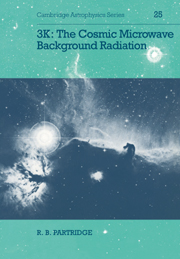Book contents
- Frontmatter
- Contents
- Preface
- 1 Cosmology
- 2 The early history of CBR studies
- 3 Radio astronomy
- 4 The spectrum of the CBR
- 5 What we learn from observations of the CBR spectrum
- 6 Searches for anisotropy in the CBR on large angular scales
- 7 Searches for anisotropy in the CBR on small angular scales
- 8 What do we learn from the angular distribution of the CBR?
- Appendix A A measurement of excess antenna temperature at 4080 Mc/s
- Appendix B Cosmic blackbody radiation
- Appendix C Recent results
- Index
8 - What do we learn from the angular distribution of the CBR?
Published online by Cambridge University Press: 17 September 2009
- Frontmatter
- Contents
- Preface
- 1 Cosmology
- 2 The early history of CBR studies
- 3 Radio astronomy
- 4 The spectrum of the CBR
- 5 What we learn from observations of the CBR spectrum
- 6 Searches for anisotropy in the CBR on large angular scales
- 7 Searches for anisotropy in the CBR on small angular scales
- 8 What do we learn from the angular distribution of the CBR?
- Appendix A A measurement of excess antenna temperature at 4080 Mc/s
- Appendix B Cosmic blackbody radiation
- Appendix C Recent results
- Index
Summary
In the standard Big Bang model (introduced in Chapter 1), the Universe is assumed to be exactly homogeneous and isotropic, and only gravitational forces between particles are considered. Under these conditions, all particles in the Universe are at rest in comoving coordinates and the CBR is completly isotropic.
The actual Universe we observe clearly differs from this idealized model in a number of obvious ways; for instance, the Universe is visibly inhomogeneous on all length scales up to many megaparsecs. Any departure from the idealized conditions assumed in the Big Bang model can introduce anisotropy into the CBR.
Sources of anisotropy in the CBR
In this section, we list briefly some cosmological processes which can introduce anisotropy into the CBR on various angular scales, starting with the largest. Suppose, for instance, that we allow large-scale magnetic fields, and not just gravity, into our cosmological model. Then the CBR will become anisotropic (Thorne, 1967). Likewise, long wavelength gravitational waves added to an otherwise homogeneous Universe will induce a quadrupole moment (Dautcourt, 1969; Burke, 1975).
A more fundamental source of anisotropy in the CBR is the anisotropic expansion of the Universe as a whole (see, e.g., Barrow et al., 1983). The cosmological equations derived from General Relativity permit a wide variety of anisotropic solutions as well as the isotropic Robertson–Walker models discussed in Chapter 1.
- Type
- Chapter
- Information
- 3K: The Cosmic Microwave Background Radiation , pp. 279 - 354Publisher: Cambridge University PressPrint publication year: 1995



